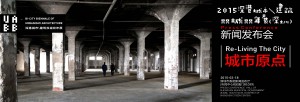2015 Shenzhen Urbanism \ Architecture Bi-City Biennale
Re-living the City
December 4, 2015 – March 4, 2016
Curated by Aaron Betsky, Alfredo Brillembourg & Hubert Klumpner, Doreen Heng Liu with ETH Zurich
Concept
The 2015 Shenzhen Biennale of Architecture and Urbanism proposes to exhibit, make, and discuss architecture that reflects the reuse and rethinking of existing buildings, the re-imagination of our cities, and the remaking of our daily lives by design. It will be a biennale of fragments, not abstract plans; of collage, not grids; of tactical urbanism, not top-down strategies.
The 2015 Biennale will present architecture and urbanism as hunting and gathering. It will collect concrete projects and fragments from around the world that we can use to construct social and economic connections. It will open up the closed structures that surround us, and propose how we can use existing infrastructure to build together.
Organized by the Hubert Klumpner and Alfredo Brillembourg of the Department of Architecture at ETH Zürich, one of the world’s most prestigious schools, in collaboration with critic and curator Aaron Betsky and architect Doreen Liu, the Bi-City Biennale will show how people around the world—both designers and laypeople—are coming together to remake their cities and environments. It will also apply those lessons to the specific case of the Pearl River Delta through high-level research, student projects, and speculative visions.
The five-part exhibition in Shenzhen will focus on site-specific installations, interactive videos, and other methods of presenting architecture and urbanism at work and in reality, rather than through representations and statistics.
Collage City 3D: An Invitation to (Serious) Play
In keeping with the theme of repurposing existing environments and materials, and architecture as hunting and gathering, the Biennale will feature a site-specific exhibition to test the idea of three-dimensional collage.
Maker Maker: An Interactive Trade Fair
Maker Maker aims to bring the best experiments in making that combine digital and hand-crafting together in one place.
Pearl River Delta 2.0: Balance is More
With a population exceeding 40 million people, the PRD is home to countless factories supported by a massive transportation infrastructure designed to efficiently transport manufactured goods. However, new demands for sustainable development and a shift toward information and knowledge as the new “goods” are forcing the region to reimagine its future.
Radical Urbanism: The Future of Urban Life Is Informal
Today more than one billion people live in slum communities worldwide, and that number is expected to double by 2030.
Although these territories are largely free of regulatory frameworks, the inhabitants themselves continually build and improvise to meet their needs, creating new prototypes of architecture and urban space. The Biennale will find and exhibit inspiring examples of these experiments. These projects call into question the role of the architect or planner in shaping urban space.
Social City
Digital technology and social networks have drastically changed city life. Our urban experience is as much virtual as it is real. The challenge of our times is to connect big data analytics to city dwellers’ shared emotional and practical needs and desires.
This part wants to answer the question: how do people want to live in the city, and how can designers work with those desires? Working with a team of researchers, the curator will enable an active website that is continually fed new information and opinions, as well as case studies and research. This work will be central to the Biennale’s website, and will serve physically as an introductory gallery.
Educational events / Learning the City
A major conference followed by ongoing public workshops and presentations will bring together leading thinkers and practitioners to discuss the future of cities and making across disciplinary boundaries.


